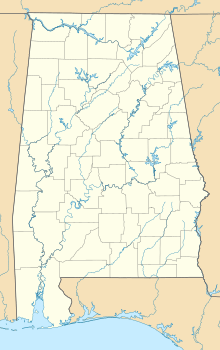Fort Bainbridge facts for kids
Quick facts for kids Fort Bainbridge |
|
|---|---|
| Boromville, Alabama in United States | |
| Coordinates | 32°19′08″N 85°26′06″W / 32.31889°N 85.43500°W |
| Type | Earthen fort |
| Site information | |
| Owner | Private |
| Controlled by | Private |
| Open to the public |
No |
| Site history | |
| Built | 1813-1814 |
| Built by | Georgia militia |
| In use | 1813-1814 |
| Battles/wars | Creek War |
Fort Bainbridge was an earthen fort located along the Federal Road on what is today the county line between Macon and Russell counties in Alabama.
Contents
History
Creek War
Fort Bainbridge is believed to be named in honor of naval captain William Bainbridge. It was either constructed in late 1813 or early 1814 by Georgia troops under the command of Colonel Homer V. Milton or General John Floyd in an effort to protect the supply route from Fort Hull to Fort Mitchell. Floyd left his supplies at the fort when he marched westward to fight the Battle of Calebee Creek. Fort Bainbridge was built in the style of a bastion fort with eight outcroppings.
Postwar
Captain Kendall Lewis, along with his Creek chief father-in law, Big Warrior, operated a tavern as a stagecoach stop about 400 yards west of Fort Bainbridge, which stayed open under the care of Lewis' widow until at least 1836. During his return tour, the Marquis de Lafayette stayed at the Lewis Tavern for his first night in Alabama. The site of the fort also lies along naturalist William Bartram's four-year journey through the Southern United States, during which he documented the flora, fauna and Native Americans of the area. The fort site was later used as a plantation.
Present
Today, it remains unmarked and its legacy lies in a small unincorporated community, Boromville, that developed from it. Though unmarked, the location is known and the area has been damaged by relic hunters.
Images for kids




